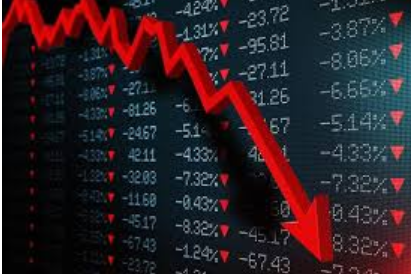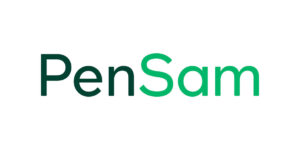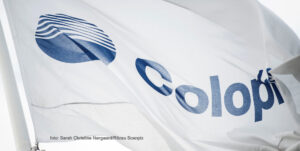Frygten for de amerikanske rentestigninger begynder nu at trykke aktiekurserne nedad – trods pæne regnskaber i første kvartal, skriver Saxo Bank. Det sker, fordi den amerikanse centralbank fokuserer på rentestigninger efter maj. Fed synes altså fast besluttet på at bekæmpe inflationen, selv om det kan gå ud over aktierne. Derimod er der bedre toner på det kinesiske aktiemarked, hvor myndighederne forsøger at styrke tilliden på markedet. I USA synes forbrugernes optimisme fortsat at være stor, og der er forventninger om en travl rejsesommer. Saxo Bank er dog bekymret for den voksende gæld i Emerging Markets, og desuden kan forsyningsproblemerne, især omkring chips, fortsat give problemer for mange virksomheder.
Fear of front-loading of Fed rate hikes sent stocks and bonds lower
Summary: The U.S. equity market moved on from focusing on strong Q1 corporate earnings to intensifying fear of more aggressive rate hikes from the Fed in the coming FOMC meetings. As Chinese stock markets approaching their key March 16 lows, the Chinese authorities have formed a chorus in an attempt to boost market confidence.
What’s happening in markets?
Sharp declines in US stocks will filter through to Asia. S&P500 (US500.I) slid by 1.5% while the tech-heavy NASDAQ 100 (USNAS100.I) was down over 2% as yields jumped higher following hawkish Fed commentary. Japan’s Nikkei (NI225.I) was down 2% in the morning as electronics and automakers also succumbed to higher yields. Tokyo Electron (8035) reversed gear and Fast Retailing (9983) remain one of the key drags as well. Singapore’s Straits Times Index STI (ES3) was down 0.6%, mainly due to Yangzijiang Shipbuilding (BS6) down 43% due to the spin-off of its investment arm.
Fed focus now beyond the 50bps May hike. Fed Chair Powell has almost confirmed a 50bps hike in May and hasn’t ruled out a few more 50bps rate hikes as well. While the Fed enters a blackout period now which means that Fed officials will stay away from any further comments for now, but US PCE index release will be on watch next week.
Hong Kong and China equities recovered from early losses. Hang Seng Index (HSI.I) was down more than 2% and CSI300 (000300.I) was off 1% in early trading, following the sell-off of Chinese ADRs overnight in the U.S. and as a continuation of the recent negative sentiment from downward revision of the growth outlook of the Chinese economy as well as fear of front loading of U.S. Fed’s rate hikes. CSI300 Index and Shanghai Stock Exchange Composite Index were just a touch above their March 16 lows.
The markets found supports and recovered, finding comforts from a number of government initiatives and rhetoric to boost confidence to the Chinese economy and stock markets. Investors are also mindful that the March 16 lows might be kind of line on the sand for the Chinese authorities to be become more proactive in supporting the equity markets. At the morning session close, Hang Seng Index was down only 0.3% and the CSI300 was 0.2% higher.
Oil/gas prices on course for a weekly decline. Crude oil (OILUKJUN22 & OILUSMAY22) continues to trade within a narrowing range around $107 in Brent and $103 in WTI. Beneath the surface, however, the market is anything but calm with supply disruptions from Libya and Russia currently being offset by lower demand in China where officials are struggling to eradicate a wave of Covid-19 in key cities. European ban on Russian crude oil and fuel imports, remains a major upside risk. US natural gas also lower by nearly 5% for the week despite temperatures shifting colder in the North, as traders took profits after prices reached a 13-year high.
Japan’s CPI higher but no shift in BOJ policy. Japan’s March CPI came in at 1.2% y/y from 0.9% (Feb), the highest since October 2018 and its 7th consecutive month of gains. Core inflation rose by 0.8% y/y in March, the 7th consecutive month of rises, the most since January 2020 but still well below BOJ’s target of 2%. Inflationary pressures in Japan are significantly lower than what we are seeing globally. BOJ’s task keeps getting complicated with the meeting due next week. They have enough to discuss, including rising inflation and yen weakness. But it is unlikely we will see any policy changes. Inflation is mostly energy-driven and there is still no wage growth.
What to consider?
Early takeaway from US earnings – a strong consumer and optimism on summer travel. Although we are still very early into the reporting season, a stronger consumer is coming out as a key theme. Companies are able to pass on higher costs and preserve margins, but it remains to be seen how long this can last. Overnight, Snap earnings were weaker than expected but user growth still beat estimates. Secondly, the reopening theme continues to support airline and airport stocks. American Airlines and United Airlines forecasted improving travels and were up last session.
Chinese authorities are in chorus to boost market confidence. Yesterday, China State Council released a proposal to promote retirement funds. China Securities Regulatory Commission (CSRC) gathered the national social security fund, large banks and insurance companies and called on them to raise allocation to equities yesterday. Joining in the chorus, the state-owned People’s Daily published an editorial piece saying that the Chinese economy is resilient and its long-term fundamentals are strong. Likewise, the state-owned China Securities Journal suggested that the Chinese stock market is at its bottom.
We are worried about emerging market debt. There are several factors which could put emerging markets into trouble: 1) the level of public and private debt shot up significantly since the outbreak began; 2) local interest rates have increased noticeably in order to fight inflationary pressures (with little success so far); 3) global rates are rising and 4) Sri Lanka’s default could trigger contagion. This is not an isolated phenomenon. A bunch of emerging market countries might have to deal with debt stress in the short- and medium-term: Pakistan, Tunisia or Ghana, for instance. In all these three countries, the debt stock is above 80% of GDP and interest rates have risen sharply over the past year.
Singapore stock index may see rebalancing. The listing of Yangzijiang Shipbuilding’s (BS6) Yangzijiang Financial Holding will take place on April 28, and it will be added to the STI Index. This means there is a chance that the smallest market cap constituent of STI, ComfortDelGro (C52) may be removed. ETFs will likely rebalance so we can expect some near-term pressure on ComfortDelGro shares.
Euro manufacturing PMIs on watch. Friday sees the flash April PMIs for Euro area, France, Germany and U.K. While current surveys have been strong, but expectations index have been sliding. PMIs may still show decent numbers, but it still cannot be ruled out that the EZ faces greater recession risks than the US due to weaker fundamentals, the physical proximity to the Russia-Ukraine war disrupting supply chains, and a higher sensitivity to rising food and energy prices.
Trading ideas to consider
Yen taking a breather, but how long? USDJPY is above 128.50 again in Asia but still below the 20-year highs of 129.40 printed earlier this week. With an aggressive upside momentum in the last few weeks and constant verbal intervention from the authorities, it is probably time to take a breather. But strong Euro PMIs should keep the JPY on the backfoot as riskier currencies get favored. The fundamental yield differential story is still intact, and 130+ levels in USDJPY remain in sight unless real intervention or policy action is seen.
Trading the line on the sand in Chinese equity markets. In near-term, the markets may hold and rally from the key support of the CSI300 and Shanghai Stock Exchange Composite March 16 lows. A break of those level to the down side is likely to damage market sentiments substantially.
Honda to cut production due to chip shortages. Honda Motor (7267) is planning to cut production by about 50% on two lines of one of its domestic factories in early May due to chip shortages and Covid-19 lockdowns. The stock was down 1.7% along with other Japanese automakers as Fed rate hikes are in focus. Automakers that mainly export will also remain a focus amid the yen weakness.







